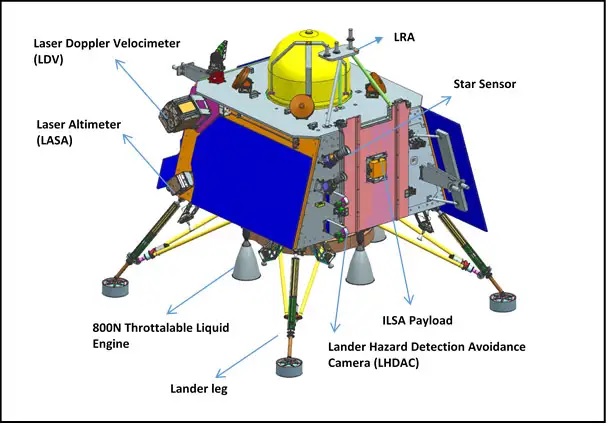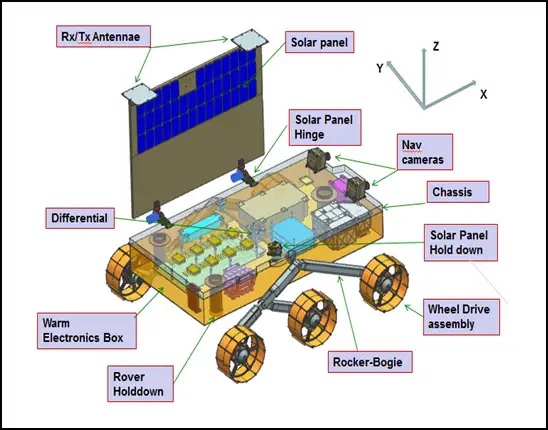As India’s Chandrayaan 3 embarks on its mission to explore the lunar surface, it brings with it a remarkable innovation known as the Vikram Lander and Pragyan Rover. Named in honor of Dr. Vikram Sarabhai, the visionary founder of ISRO, this autonomous vehicle is set to revolutionize lunar exploration and expand our understanding of the Moon’s terrain and composition.
Vikram Lander and Pragyan Rover: An Engineering Marvel
The Vikram Lander and Pragyan Rover is the product of ingenuity and meticulous engineering. Designed to traverse the challenging lunar landscape, it’s equipped with advanced navigation systems, high-resolution cameras, and cutting-edge sensors. This enables the rover to maneuver safely, capturing detailed images and collecting crucial data for analysis back on Earth.
Name of Lander and Rover and Reason Behind It
Similar to Chandrayaan-2, Chandrayaan 3 consists of a lander named Vikram and a rover named Pragyan. Lander Vikram is named after famous scientist Dr Vikram Sarabhai, who founded the space program of India. Vikram name represents bravery and valour. The rover name Pragyan is a Sanskrit word, which mean ‘Getting knowledge’ or ‘wisdom’. ISRO gives these names purposely due to their meaning.
Vikram Lander Mechanism and Touchdown Specification
- Lander’s leg
- Rover Ramp (Primary & Secondary)
- Rover
- ILSA, Rambha & Chaste Payloads
- Umbilical connector Protection Mechanism,
- X- Band Antenna
Vikram Lander Touchdown Specification
- Vertical velocity: ≤ 2 m / sec
- Horizontal velocity: ≤ 0.5 m / sec
- Slope: ≤ 12 deg

The scientific objective of the Chandrayaan-3 Vikram Lander Module and Pragyan Rover
- To assess the near-surface plasma density (ions and electrons) and its temporal variations
- To conduct observations of the lunar surface’s thermal characteristics close to the polar zone.
- Determining the structure of the lunar crust and mantle and measuring seismic activity near the landing site.
- In order to comprehend the dynamics of the Moon system, this experiment is passive.
- Elements of qualitative and quantitative analysis To advance our understanding of the lunar surface, we must determine the chemical composition and deduce the composition of the minerals.
- Determine the soil and rocks surrounding the lunar landing site’s elemental makeup (Mg, Al, Si, K, Ca, Ti, Fe).
- To investigate a variety of Exo-planets that might qualify for habitability (or for the presence of life) through future discoveries of smaller planets in reflected light.
Scientific Discovery
The Vikram Land Rover is key to Chandrayaan 3’s mission objectives. It will serve as an invaluable tool for studying the Moon’s surface features, geology, and potential resources. By traversing the landscape and collecting samples, it promises to provide insights into the Moon’s history, formation, and evolution over billions of years.
Exploring the Lunar South Pole
One of the most significant aspects of the Vikram Land Rover’s mission is its targeted exploration of the Moon’s South Pole. This region is of immense scientific interest due to the presence of permanently shadowed areas that might contain water ice. The rover’s instruments will analyze these areas, contributing to our understanding of lunar resources and potential future missions.
Operational Autonomy
A standout feature of the Vikram Land Rover is its autonomy. Once deployed onto the lunar surface, the rover can navigate and execute its scientific tasks without direct human intervention. This capability not only minimizes operational challenges but also maximizes the efficiency of data collection and transmission.
Complementing the Orbiter
The Vikram Land Rover works in tandem with the orbiter module of Chandrayaan 3. While the orbiter surveys the Moon from a higher vantage point, the rover’s ground-level exploration provides a comprehensive view of the lunar environment. This synergy enhances our understanding of the Moon’s geology and resources, amplifying the mission’s overall impact.
Inspiration for Future Missions
The Vikram Land Rover represents a significant leap forward in India’s space capabilities. Its success will inspire future generations of scientists, engineers, and explorers, encouraging the pursuit of groundbreaking innovations and ambitious space missions. The knowledge gained from this mission will undoubtedly contribute to the planning and execution of subsequent lunar and interplanetary endeavors.
Read Also: Chandrayaan 3: India’s Ambitious Lunar Mission for Scientific Discovery



